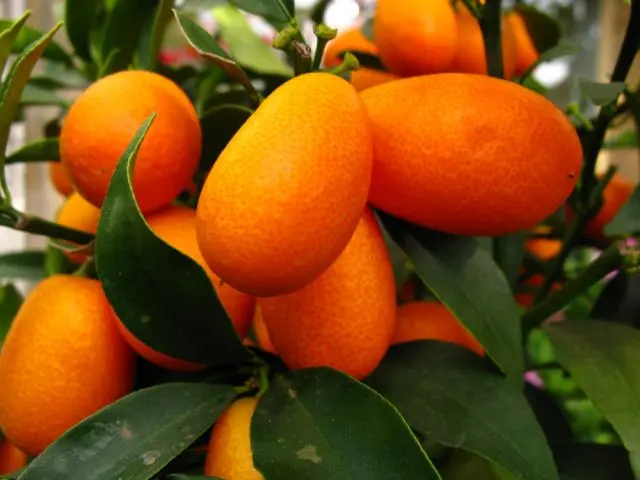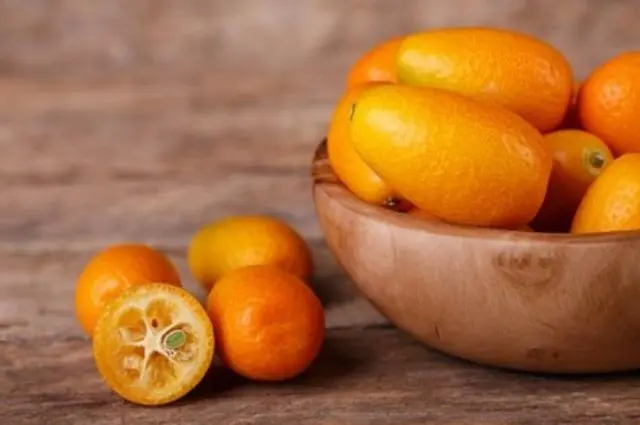Contents
Kumquat is a fruit that has an unusual appearance and a lot of useful properties. Since it is still exotic in stores, it is interesting to study the characteristics of kumquat and understand what effect it has on the body.

What is this exotic kumquat fruit
The kumquat plant belongs to the Rutov family and belongs to the genus Fortunella, which is closely related to citrus fruits. Externally, the plant is an evergreen shrub that can reach 4 m in height. The leaves of the kumquat are green, smooth and oblong, the crown is usually spherical and small.
Kumquat blooms late, from July to August, and produces white and pink fragrant flowers. They remain on the branches of the tree for only about a week, however, a feature of the kumquat can be considered that the plant is capable of re-blooming after 2-3 weeks.
The exotic kumquat is best known for its fruits, which ripen in December or January. The fruits of the plant are very interesting, they are covered with yellow or orange dense skin, reach a diameter of only 2-4 cm and can be either round or oblong. Inside the kumquat fruit is juicy and sweet pulp, divided into several narrow slices with a small number of small seeds.
What fruit is most similar to kumquat
Outwardly, the exotic kumquat fruit looks like an orange, it has similar outlines, skin structure and color. However, the kumquat is closer in size to a plum. As for the composition, the fruit is closest to the tangerine and is very similar in taste to it, only the sourness in the kumquat is more pronounced.
What is the difference between red, orange and green kumquat
As the exotic kumquat slowly gains popularity, several varieties of this plant are currently being cultivated. The color of the fruit depends on the variety; orange, red and even green fruits can be found on sale.
- Orange is the most natural color for a kumquat. Ripe fruits of most varieties have this color, and the internal differences between them are mainly in shades of taste and in the size of the fruits.
- Kumquat is red, for example, the skin of the fruits of the Hong Kong variety has this shade. However, the rich red fruits of this variety are classified as inedible, and only fruits with a red-orange peel can be eaten.
- Kumquats come in green varieties, such as the ‘Limequat’, which is a hybrid of a kumquat and a lime. The taste of such a fruit is slightly bitter, and lime notes are clearly distinguished in its aroma.
Where does the kumquat grow?
The wild kumquat grows in the southern regions of China. As for artificial cultivation, the plant is cultivated in Japan and China, in Southeast Asia and southern regions of Europe, in the Middle East and in the southern United States. The kumquat is also bred in Our Country – in the Crimea, in the Caucasus near the Black Sea, in Abkhazia.
The kumquat is quite sensitive to growing conditions, requiring a hot and humid climate with plenty of sunlight. In cold and dry regions, the fruit feels bad, so its artificial breeding is associated with some difficulties.

The composition and calorie content of kumquat
The value of the fruit lies not only in its original appearance and pleasant taste. Kumquat benefits health because it has a rich and varied composition. The pulp of the fruit contains:
- vitamins B1, B3 and B2;
- vitamin A;
- ascorbic acid;
- phytosterols and flavonoids;
- antioxidants;
- fatty acid;
- essential substances pinene, monoterpene and limonene;
- iron and calcium;
- manganese, magnesium and potassium.
The calorie content of the Fortunella fruit is quite low – only about 100 kcal are present in 71 g of pulp.
What is useful kumquat for the body
With regular use, fresh and ripe kumquat can have a beneficial effect on human health. In particular, the benefit is that the fruit:
- increases the protective functions of the body and prevents the development of viral and infectious diseases;
- strengthens blood vessels and increases their elasticity, and also lowers bad cholesterol;
- serves as a prevention of atherosclerosis and supports the healthy functioning of the heart and brain;
- positively affects the condition of the skin, promotes its rejuvenation, nourishes and moisturizes the epidermis;
- well reflected in the condition of hair and nails;
- Beneficial for weight loss and helps to speed up the disposal of excess fat;
- has a beneficial effect on the nervous system, therefore it is of great benefit in depression, insomnia and increased anxiety;
- improves the condition with joint and headaches, helps to relieve inflammation and reduce swelling;
- strengthens vision and relieves eye fatigue, therefore it is especially useful for people who are forced to spend a lot of time at the computer screen.
Due to its positive effect on blood vessels, kumquat is very useful for pressure, it is especially appreciated by hypertensive patients. It helps lower blood pressure and helps maintain it at a normal level.
Fresh kumquat contains quite little sugar and does not lead to sharp increases in glucose levels – the glycemic index of kumquat is 35 units. Therefore, it can be used in this disease. This will be beneficial, the fruit will speed up the metabolism, prevent the development of obesity and have a beneficial effect on blood vessels. However, kumquat in type 2 diabetes should be eaten with caution and in small quantities, no more than 100 g per dose and no more than twice a week.
Kumquat for pregnant women is not only possible, but necessary. The benefit is that the exotic fruit helps get rid of puffiness and constipation, and also relieves the painful symptoms of toxicosis. It can only be damaged if a woman is allergic to citrus fruits or an exacerbation of chronic gastric diseases. Also, do not abuse kumquat, the fruit can lead to an increase in the tone of the uterus.
But the benefits of kumquat during menstruation are ambiguous. On the one hand, it replenishes the deficiency of valuable substances in a woman’s body and raises hemoglobin, and also has a tonic effect. But on the other hand, kumquat, like any citrus, stimulates additional uterine contractions, and with painful periods, this can only increase discomfort.

Can kumquat cause cystitis?
In small quantities, citrofortunella kumquat cannot cause the development of inflammatory processes in the urinary tract. However, with excessive use, the occurrence of cystitis is really possible.
- Since kumquat is a citrus fruit, it contains a large amount of organic acids. In excess, they irritate the mucous membranes not only of the stomach, but also of the intestines and bladder. This can provoke the onset of the inflammatory process and lead to cystitis.
- The acids in the fruit affect the level of urine acidity, the more the pH balance shifts, the more favorable conditions are created for the reproduction of bacteria. Thus, a small infection on the background of the use of kumquat can turn into an acute and unpleasant disease.
In order to avoid problems with the bladder, you need to consume tropical fruit in limited quantities. If there is already inflammation in the urogenital area, then kumquat should be temporarily abandoned until the condition returns to normal.
Fresh kumquat: how to eat it, with or without skin
The small citrus fruit of the kumquat is unique in that it is customary to eat them along with the peel. If desired, it can be removed, but the skin of the kumquat has a pleasant sweetish taste, contains a large amount of valuable vitamins, so the fruit brings even more benefits with the skin.
Due to the small size of the kumquat, you can eat it by first cutting it into slices or simply biting it as a whole. In this case, you should spit out the seeds of the fruit, they have an unpleasant bitter taste and are not of particular benefit.
Most often, kumquats are consumed alone as a refreshing fruit dessert. But also pieces of fruit can be added to cottage cheese and yoghurts, cereals and muesli, pies and fruit desserts. Kumquat will be appropriate in fruit salad, it is combined with meat and fish, and sauces and homemade sweets are prepared based on it.
Is it possible to eat kumquat on a diet
The calorie content of a tropical fruit is very low, so the beneficial properties of kumquat are well manifested when losing weight. When included in the diet, the fruit helps speed up the digestive processes and remove toxins from the body, as a result, parting with extra pounds is faster.
Of course, to get the benefits, you need to use kumquat on a diet in small volumes. In conditions of a limited diet, it can have a strong irritating effect on the stomach and intestines. It is not recommended to eat the fruit on an empty stomach – it is better to eat it after the main meal.
How much can you eat per day
The benefits and harms of kumquat for the body are determined by the dosages of the tropical fruit. You can eat small citrus fruits daily, but for adults, the daily allowance should not exceed 8-10 small fruits. In case of an overdose of the fruit, organic acids in its composition can damage the stomach, in addition, an excess of vitamin C is dangerous for the body, it can manifest itself with side effects such as nausea, diarrhea and an allergic rash.

It is recommended to offer kumquat to children no earlier than after 3 years and provided that there is no allergy to citrus fruits. You need to start with just half a tropical fruit per day, gradually the amount of kumquat can be increased and by the age of 5 bring the daily rate to 4 fruits per day. It is worth adding kumquat to the diet no more than three times a week – then it will be useful.
Limitations and contraindications
For all its high benefits, an exotic fruit can harm the body in the presence of certain diseases. Contraindications for kumquat are:
- allergy to citrus fruits – the use of fruits can lead to swelling and rash, nausea, diarrhea and headache;
- gastric ulcer and pancreatitis – with an exacerbation of these ailments, kumquat will have a strong irritating effect on the mucous membranes, so it must be excluded from the diet until remission occurs;
- gastritis with high acidity – citrus fruit can lead to heartburn, and in the worst case, it will exacerbate the disease or cause an ulcer;
- cystitis, since the use of kumquat greatly affects the level of acidity of urine, with inflammation in the urinary tract, it is better not to use tropical fruit;
- breastfeeding – babies are often allergic to citrus fruits, so kumquat fruits should be introduced into the mother’s diet no earlier than six months after birth.
With caution, you need to eat fruit with diabetes – kumquat can be beneficial, but only with limited use.
Conclusion
Kumquat is a fruit with many health benefits and a very pleasant refreshing taste. When using it, it is recommended to adhere to small dosages so as not to harm the stomach and intestines. But if you approach the use of fruits correctly, then kumquat will only help improve well-being.









